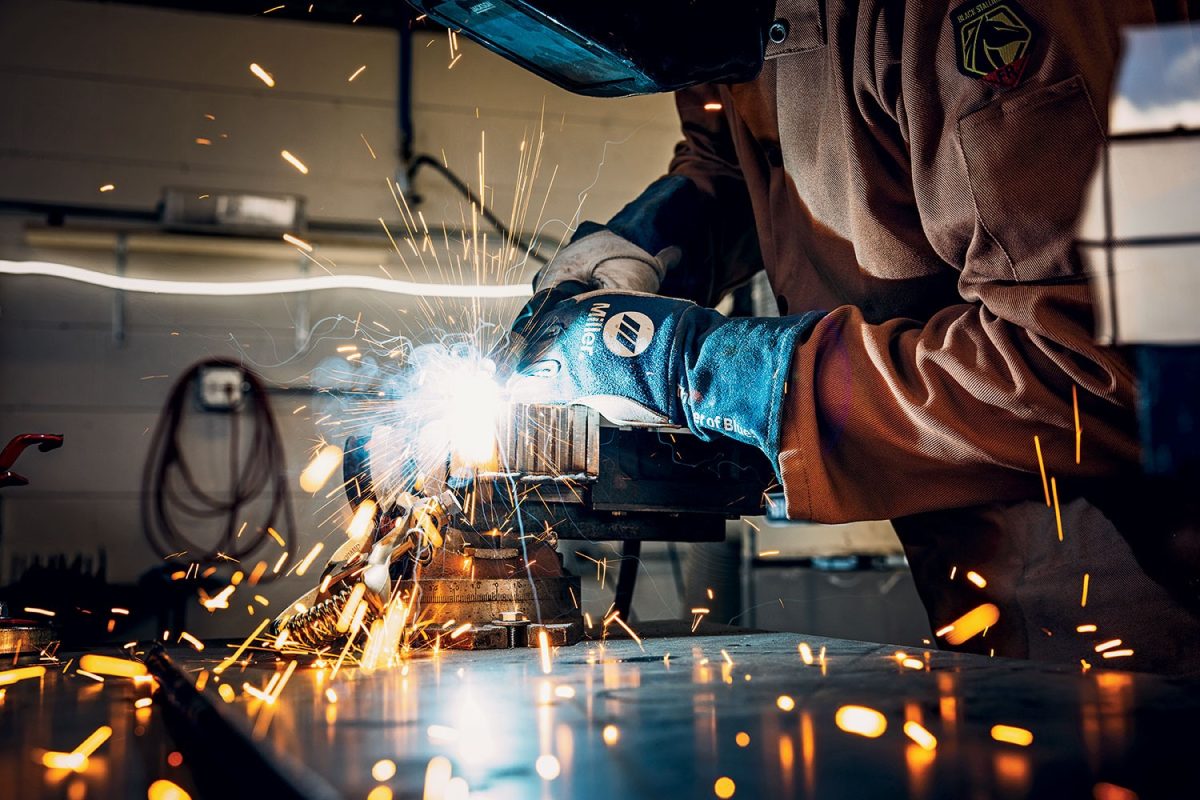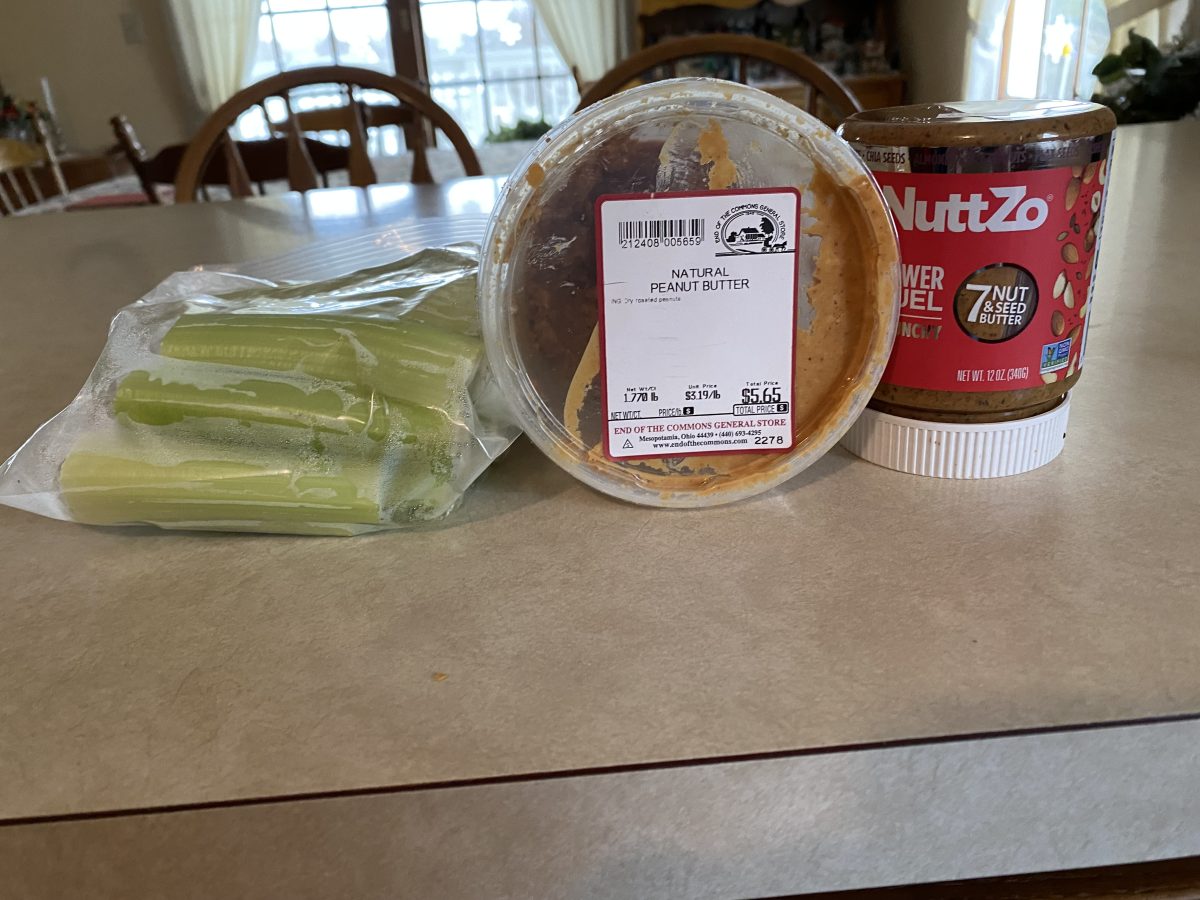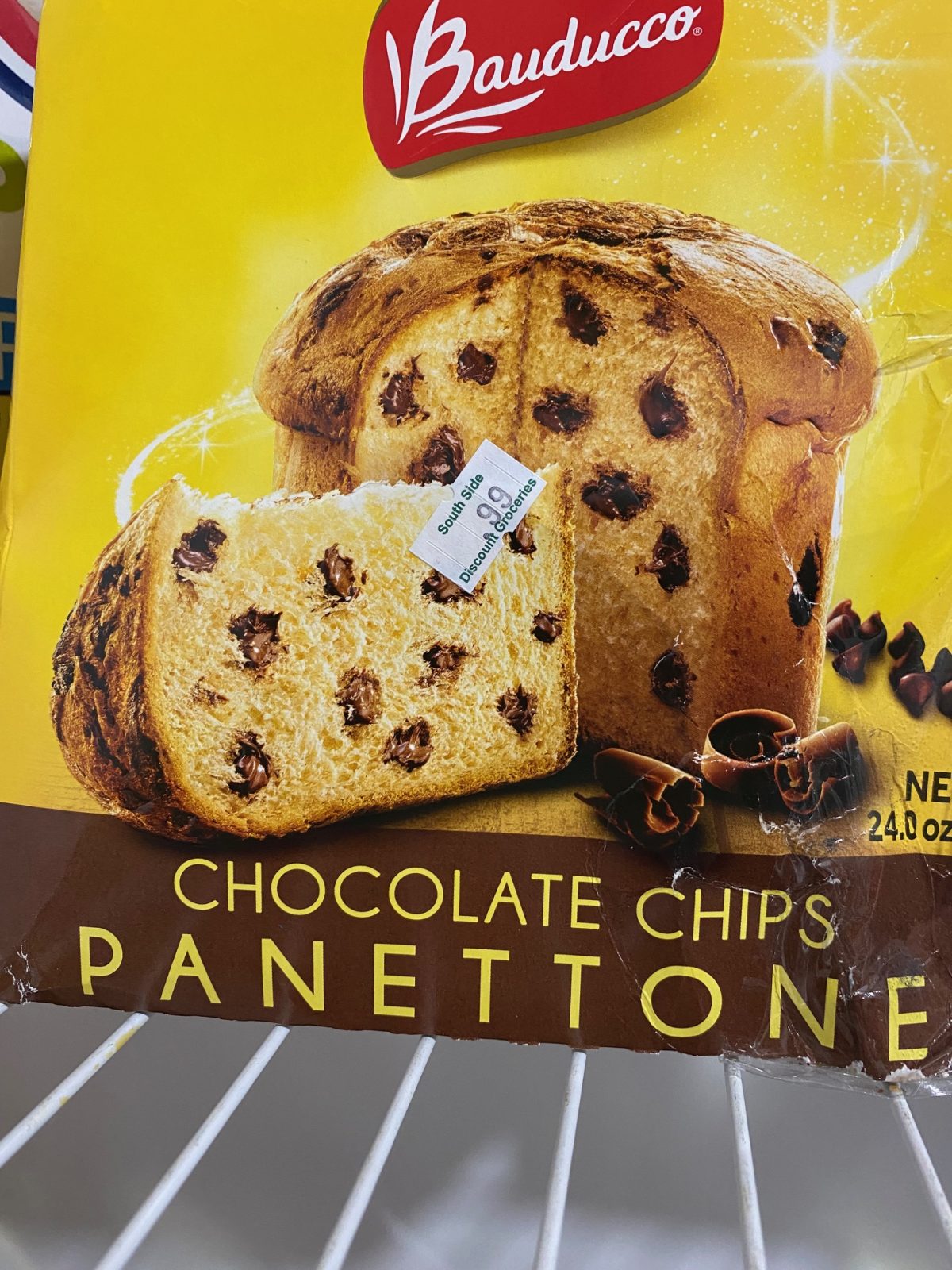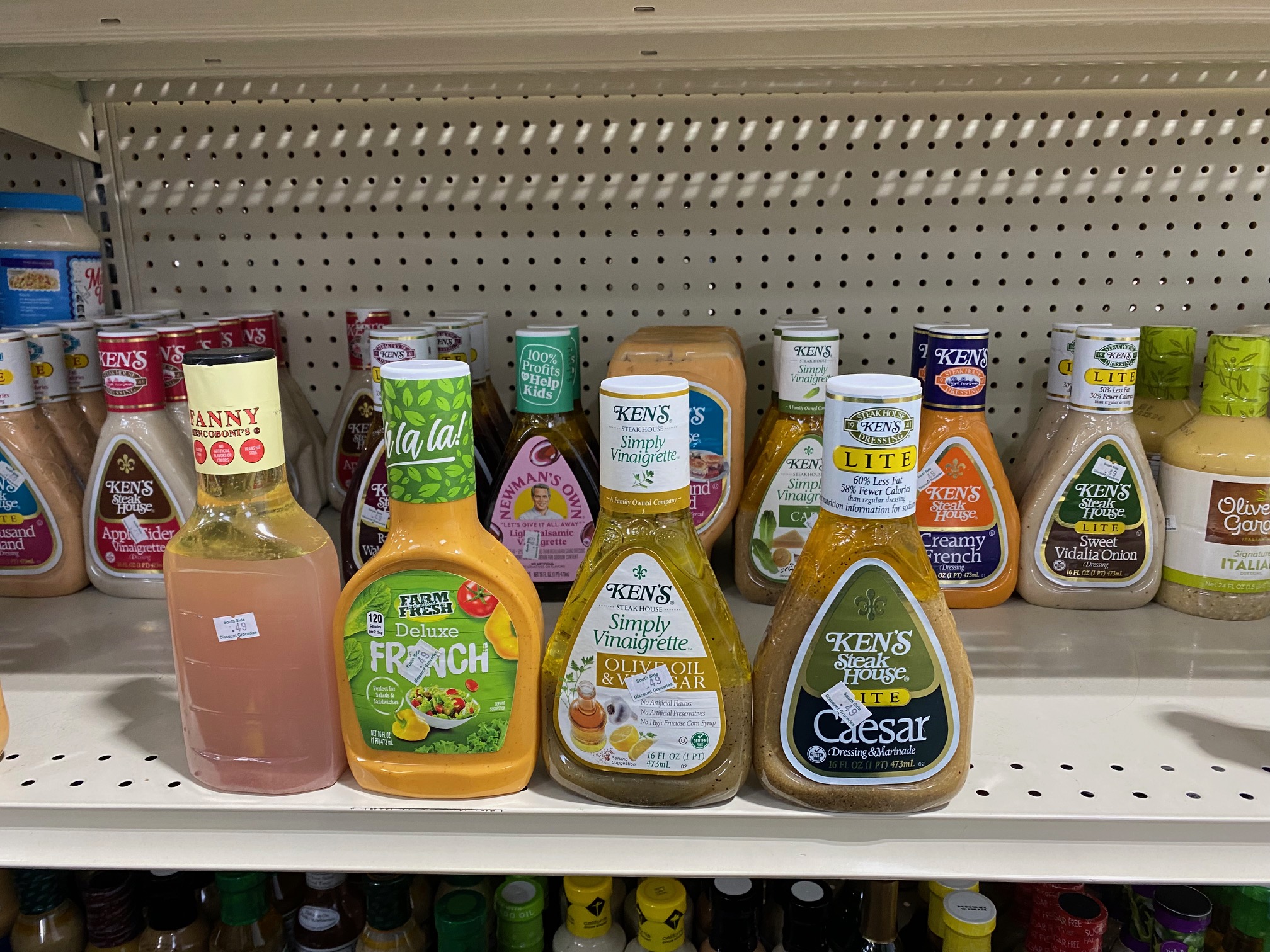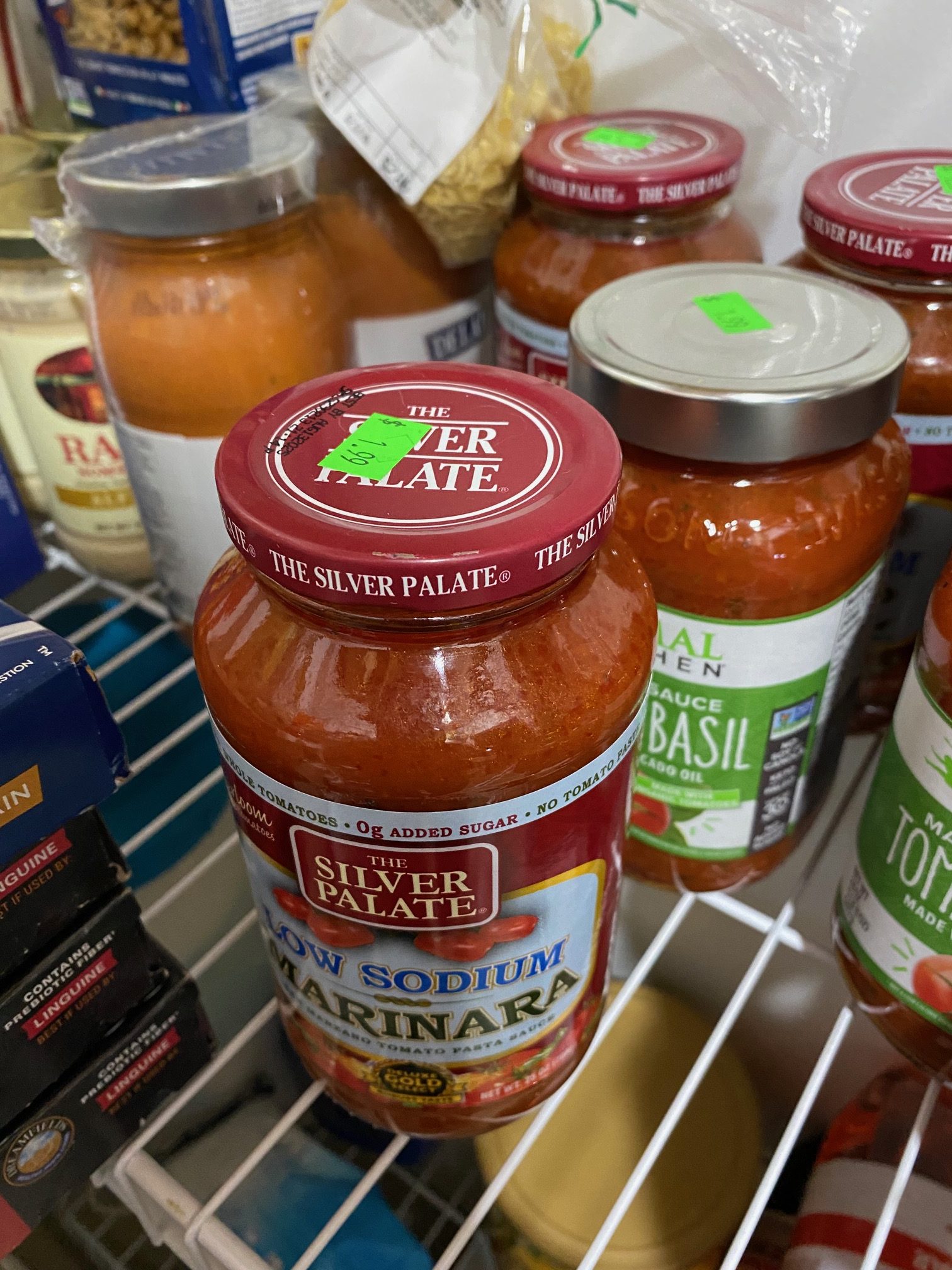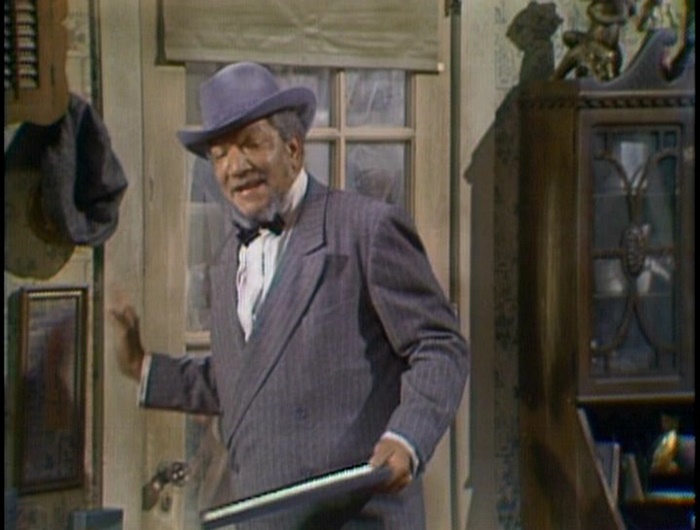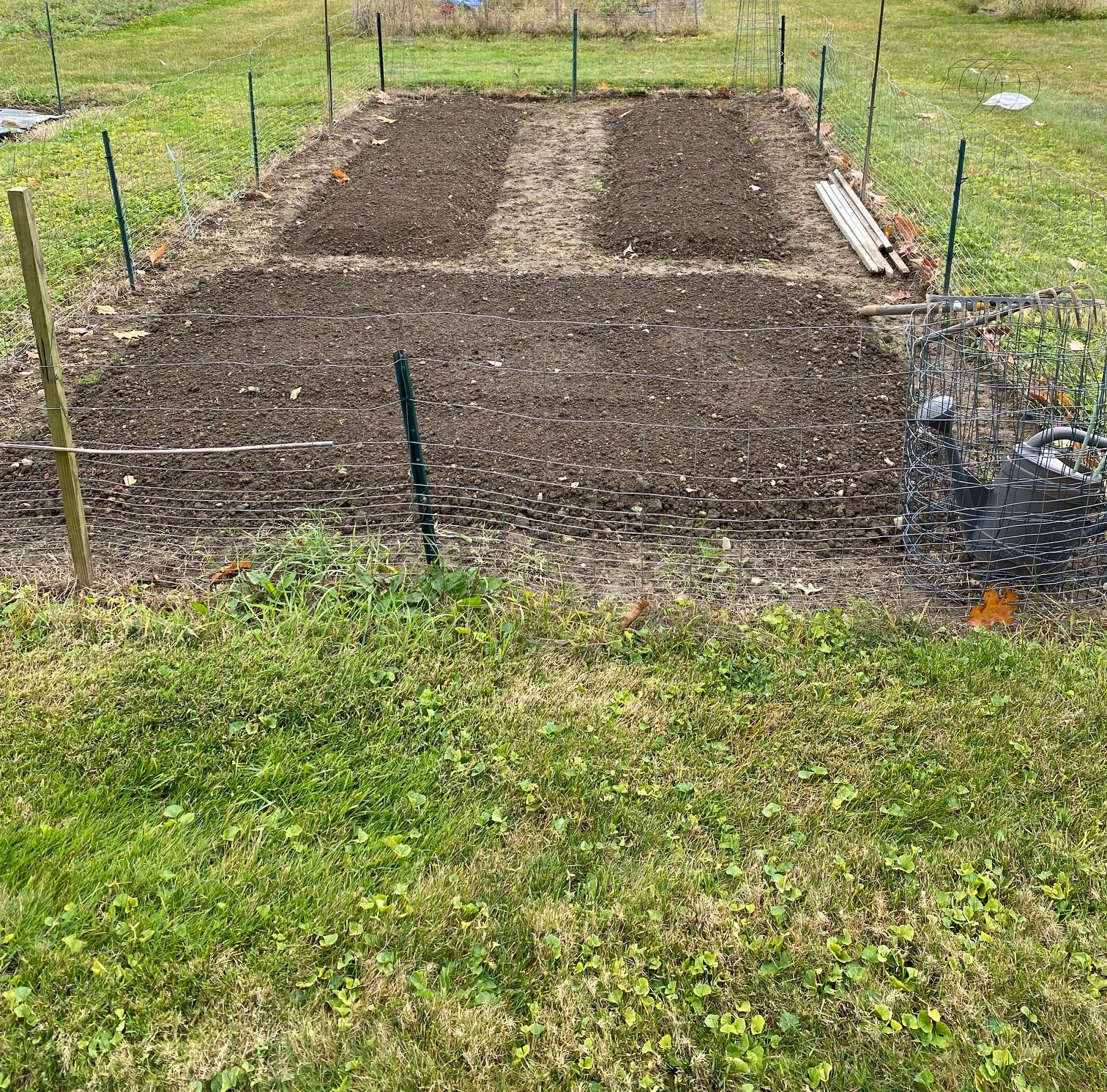Views: 29
A Knife Forged in Fire.
The author wanted a Japanese-style kitchen blade made for him by hand. What he witnessed was a combination of artistry and atomic magic.
Sam brought out what looked like a deck of tarot cards with nothing on them. No Hermit. No Hanged Man. No Fool. They were gray, thicker than ordinary cards, and clearly heavy in his hands. Inside of them a message waited. He had a long ritual to perform to release it.
As he shuffled the cards, they clattered together, revealing the first hint of their message: They were made of steel. He stacked them and squared up the edges so that all of the cards were nice and straight, nothing sticking out or crooked. Everything neat. The alchemical precision favored by Newton in his dim laboratories.
He clamped them in an industrial vise. Now the cards made a block about the size of a thick paperback book. They would never be individual cards again, these 12 pounds of two different kinds of steel, arranged in alternating layers.
The vise was mounted on a large metal table in the shop that Sam shares with his two brothers, who are fine woodworkers. The shop is in Skokie, which means “marsh” in the Potawatomi language, for these environs were once rich and populous wetlands before they were drained and turned into rows of low industrial buildings like this one and sturdy, modest residential homes. But the brothers have transformed this space into a marvelous cabinet of wonders in which to create whatever they might dream. Much of what is inside could have come from the 19th or early 20th century, great cast-iron machines of fabulous design, embossed with symbols no longer thought necessary to display on slick modern devices. In addition, some of the things in this sprawling realm of clutter might have come from another galaxy, like the ballistic cartridge for the table saw. If you accidentally touch the blade, it senses electrical conductivity and retracts. It’s gone so fast that it can’t cut you. It’s all part of the magic of this place of transformations.
Sam lowered his black face shield and picked up the MIG welder and pulled the trigger. The room lit up to an intensity such that Sam was cast as a silhouetted troupe of antic spiders dancing on the walls and floor and ceiling, sparks flying around him like a cracked nest of hornets and in his hands a burning blue hole at the center of things. All this to the roar of the forge’s fire across the room, heating up toward 2,400 degrees, and the insect chattering of the welder chewing away at liquid metal.
Sam bent over the light, his body curved around it like some sorcerer who’d caught a star and had it pinned there on the bench and was leaning over to examine it and chip away the edges. The bits were falling all around him and bouncing up in little arcs off the diamond floor of heaven. It was positively spooky the way that light stole the glory of the crisp and sunny autumn day outside the open roll-up door.
When he was done and I could look more closely without safety glasses, I saw that he had tacked the cards together with a misshapen bead of melted metal at each end of the stack. As a 12-pound solid oblong block of steel with runes inside, the stack would now be called a billet. To finish it off, he welded a two-foot length of steel rebar to one end to make a handle so that he could hold it.
Sam is afraid of some of his machines in the way that the lion tamer is afraid of his cats. You are confident. You know your skills. You have been doing this a long time. But you know that wild animals are always wild animals, and a false gesture, perhaps an unexpected noise, could set in motion events that could not be stopped. This pact requires utter honesty, complete truth. Sam is harnessing powers that few of us ever encounter in our lives. He’s directing them in order to reach down inside of this deck of tarot cards and transform the very atomic nature of its being. He’s doing what sorcerers do: magic.
John Maynard Keynes, a British economist, owned some of Isaac Newton’s papers. They were about alchemy, which was Newton’s lifelong obsession. Keynes gradually came to the conclusion that Newton “was not the first of the age of reason.” No, Keynes said, “he was the last of the magicians.”
Not the last. We have some right here in Chicago.
Sam Goldbroch is a knife maker. He was getting ready to make me a traditional Japanese-style kitchen knife.
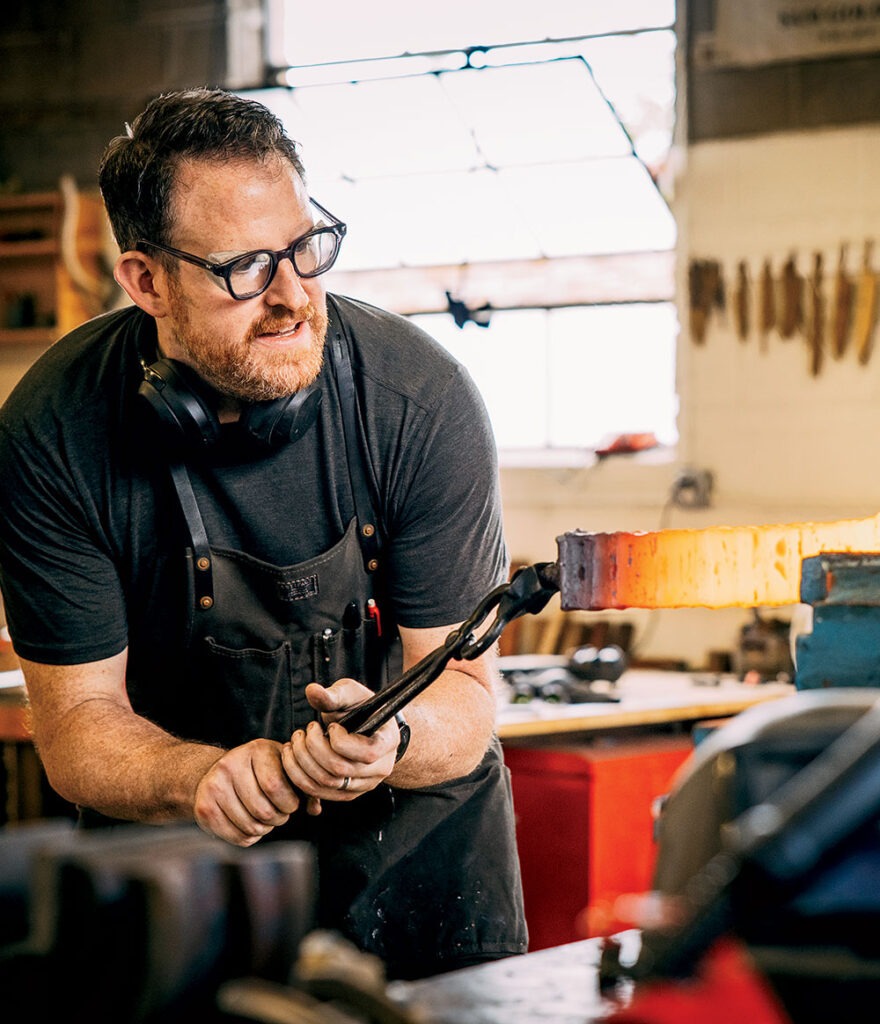
I first met Sam when he was just a kid. I’d see him and his family — his parents, Claire and Bernie; his twin brother, Phil; and their older brother, Simon — at events in the neighborhood near Dewey Elementary School in Evanston where we all lived. My elder daughter, Elena, and Simon began dating in high school and are now married. The boys, as we came to call them, all went into the crafts — Phil and Simon into wood, Sam into food initially. He worked as a chef in various capacities at some of Chicago’s best restaurants, such as Blackbird, Elizabeth, and North Pond. But when he and his wife, Julie Zare, decided to start a family, they realized that a chef’s grueling schedule would not encourage the best home life. So in 2016 Sam began teaching at the Chopping Block, the Lincoln Square school for home cooks. As he taught his students how to use knives in the kitchen, he saw that he really didn’t know anything about them, though he had used them in professional kitchens for 12 years. And with a simple question from one of his students — “What makes a good knife?” — his life was swallowed up into the mysteries of metal and fire and force.
Both the Northeast of the United States and the Northwest have robust communities of knife makers. The American South has even more. Chicago and the surrounding area are just beginning to coalesce into a serious community of bladesmiths. You can see a sample of their wares at Northside Cutlery in North Center, a small and tidy shop of beautiful, handcrafted pieces displayed in a wall-size cabinet Phil Goldbroch made for that purpose. The knives sell for a few hundred to a few thousand dollars each. They are all one of a kind, made by a variety of local bladesmiths.
Sam recently hosted a group of Chicago knife makers for a potluck lunch at the shop. After the meal, Sam cranked up the forge, and one of them, Dylan Ambrosini, crafted a blade while we all watched. Dylan, at 24, is one of the youngest and most talented knife makers in the Midwest. He and Sam collaborated on a nine-inch chef’s knife, which sold for $950 before they could get it on display at Northside Cutlery. Top-end chef’s knives can cost even more. Anthony Bourdain bought one of his favorites for $5,000 from Bob Kramer, a popular bladesmith in Washington State. It brought $231,250 at auction after Bourdain’s death.
In Sam’s kitchen and in the shop, I had seen a kind of knife called a Nakiri. I wanted one. If you’re a knife nut, as I am, that’s all you have to say. Jacques Pépin, the popular French chef, once said that you need only three knives to cook well. “That being said,” he quipped, “I probably have three hundred knives at my house.” People who love cooking can’t always say what makes them fall for a particular style of knife. Most chef’s knives are at least eight inches long, which feels too big for me. Sam had already made me a chopping knife called a tall petty, whose blade was five inches long. “Tall” means that my fingers clear the cutting board, and “petty” means that the blade is short. I use it all the time for chopping, but sometimes it’s too short, as when I have a big onion. I wanted one that was a little longer. The nakiri is ideal for preparing vegetables, which is most of what I do. I have always loved the shape. And I knew that Sam would make his own Damascus steel for this knife. The blade and handle would mate to make a work of art that was an exceptional tool. When I had my first dream about this knife, I woke up and knew that I had to have it.
I decided that I wanted to follow Sam as he made my knife, to understand the process from start to finish. I did not expect that I would stumble upon a mystical and transcendent experience in the making of such a seemingly simple tool.
As my father used to say, there’s a mile of wire in a screen door.
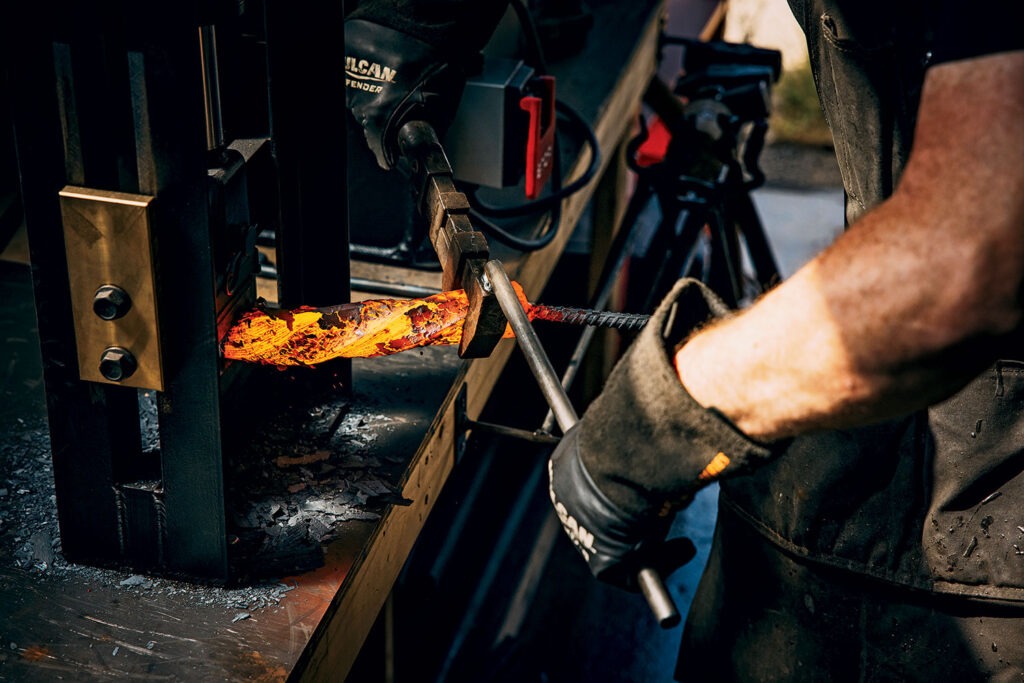
Sam took the billet of steel, holding it by the rebar handle in a heavy blacksmith’s glove, and he carried it to the forge, with its interior of tangerine flame. The forge is a black cylindrical furnace, 16 inches long, as big around as a gallon of paint, and open at both ends. Two propane torch nozzles entered the top to provide the fire. The floor of the forge was populated by glowing white rocks of fractured firebrick. And it roared like a lion. The heat rising from it was so intense that the waves appeared to be dissolving the brick building I could see across the alley through the open roll-up door. I sat at Sam’s workbench. Although I was 20 feet away, the heat on my face was like summer sun.
Sam placed the billet among the white-hot rocks and we waited. He talked of the metal’s need to heat all the way through and “relax.” As we watched, the dull deck of gray cards began to wake up and take on the qualities of a living thing. Among the glowing rocks, it seemed to stir and issued a low, dark color. He had put two kinds of steel in the stack that became the billet, 1095 and 15N20, because he was making Damascus steel, a special kind of steel for swords and knives that combines metals to form beautiful patterns by way of forging and pounding, crushing (called “upsetting”) and twisting. Damascus is not particularly superior to other steels. It’s just prettier. But it has acquired a special mystique because hundreds of years ago, as early as the fourth century B.C., it came into Europe from the East by way of Syria. That steel had a wavy pattern in it. So by analogy, people today call steel that has a wavy pattern “Damascus.” The Crusaders were armed with Damascus blades. It was said that theirs were quenched in the blood of dragons. And it was also said that those blades could do battle with the Saracens and afterward still sever a feather floating in midair.
If you want to know what rock is like deep in the earth, you can see it here in the shapeshifting of the metal. These are the energies that we are not used to in the quiet simmer of our daily lives.
I watched the forge. It took a long time, but it had our attention the way a green shoot would where only some damp sand had been seen before. Something was changing. Transformations were coming. If you want to know what rock is like deep in the earth, you can see it here in the shape-shifting of the metal. These are the energies that we are not used to in the quiet simmer of our daily lives. The energies of the deep earth and the high sun, the two sources that power our planet.
Half an hour passed, and now the billet was no longer gray. It had taken on the look of a bright confection of orange marzipan. Sam put on his blacksmith’s gloves. The billet was so hot that he wore glasses tinted against infrared radiation. He lifted the billet out of the forge for the first time to check the color of the metal. The rebar sagged like a fishing rod with a swordfish on the line. He wasn’t pleased with that, but he liked what he saw on the billet, and so he swung it over to the 12-ton hydraulic press just a few feet away. The billet landed on the compression platform. Holding the rebar in his left hand, he brought down the handle on the press with his right, moving the square metal die down to gently tap the mushy billet with a few tons of pressure so that he could see if it had been heated through and through. He had to make sure that his welds were holding the cards together. The smith calls this process of initial compression “forge welding,” because if everything is right with the stack, the cards will meld into one solid piece.
As the cards of metal were deformed and compressed, the surface of the billet rippled and changed color as if in emotional response to the extremes of heat and force, turning gray and deeper orange and shedding dark flakes of oxidized metal. Sam tapped the handle and added more pressure. Waves of dull gray cascaded across the surfaces and calved off and fell to the floor. But the billet held together. First success. It had cooled enough now that Sam had to return it to the forge to reheat it to a working temperature of about 2,300 degrees.
While it was heating, Sam unbolted the flat dies from the press using a socket wrench. Dies are the parts of the press that actually make contact with the hot metal. He exchanged the flat ones for more rounded ones that are called drawing dies. They would draw the billet into an elongated shape and help start to flatten it.
When the billet was hot enough once more, Sam began compressing it more aggressively to transform it into what he called a bar. In the middle of this, the rebar handle melted, menacingly clattering to the floor, ringing and dancing, and Sam stepped gingerly back to let it settle, then continued his work by lifting the billet with heavy tongs. There was no stopping now. He would succeed or fail by the skill of his hands and his knowledge as a bladesmith.
A natural, lifelong student of anything interesting, Sam got his start by trying to answer that question of what makes a good knife. He began to buy knives of good quality, but old and beat up, to restore them. He talked to knife makers and chefs who knew about knives. He took blacksmithing classes in which he began to acquire a feel for metal, not as the solid that most of us are used to but as a substance every bit as malleable as potter’s clay. He began to get a feel for taming the fire.
Heating and crushing now with more and more force, Sam gradually transformed the billet into a crude bar of steel so long, about a foot and a half, that it hung out either end of the forge. He then took the bar back to the metal table and clamped it into the vise. He put on his ear protection and picked up an angle grinder. At 1,000 degrees, the steel had gone dark.
Sam turned his grinder to cut from the other side, and an orange volcano shot up to the ceiling. He explained that you can tell the kind and quality of steel you’re working with by the color and shape of the sparks.
To make my little six-and-a-half-inch nakiri knife, Sam didn’t need all 12 pounds of steel that he’d started with. But the process of forging Damascus steel is so difficult and time consuming that he wanted to make as much as possible in a single batch. As he began cutting the bar in half, orange sparks cascaded down, elves of fire skipping across the concrete and dancing away into the sunlight in the alley. He turned his grinder to cut from the other side, and an orange volcano shot up to the ceiling. He explained that you can tell the kind and quality of steel you’re working with by the color and shape of the sparks.
Cutting through the bar took the better part of an hour, as he heated it to soften it and attacked it again and again with different tools. After destroying several angle grinder blades, he brought out a chisel he’d forged in a blacksmithing class and began hammering it into the cut he’d made in the bar. The making of Damascus steel takes a heavy dose of artistry and craftsmanship, and if one approach doesn’t work, you try another and another until the thing in your head becomes a thing in the world. At last he had the metal bar hot and nearly severed and clamped in the vise, and with his blacksmith’s hammer, he swung for the fences and knocked half the billet across the room. Fortunately, no one was in the path of the projectile, which landed, smoking, on the floor by the forge.
When the two black hunks of metal had cooled to a few hundred degrees, they took on an almost melancholy gloom of blue-gray, dashed with a distemper of rust, and their random-seeming warts and scars gave them the aspect of objects that had made a long and lonely journey through space, ending with a fiery entry into our world. Only the squared-off shape of these meteorites betrayed the hand of man.
Sam picked up one of the chunks with his tongs, saying, as unlikely as it seemed at that moment, “There’s a knife in there. That’s all that matters.” He also mentioned that the worst accidental burns in a forging shop occur when the metal has cooled off to black and is still at several hundred degrees. The visitor learns to touch nothing.
Now that he was working with a billet that weighed six pounds instead of 12, he could proceed much faster. Moving from forge to hydraulic press, heating and upsetting and turning, occasionally changing dies to different shapes, Sam gradually formed the bar into a piece about 16 inches long and an inch and a quarter square. Some time before, Sam had acquired a rusty old-fashioned monkey wrench. He had welded a piece of steel round bar to the head to make a long and heavy wrench for one specific purpose: twisting a bar of hot Damascus steel. Now he heated the bar and clamped it with the hydraulic press just enough to immobilize it, not enough to deform it. Then he fitted the adjustable wrench to it. Because the bar was now square in cross section, he could maintain a grip on it, as with a wrench on a nut. But when he went to twist it, he managed to turn it only halfway around. It wasn’t hot enough.
He put it back in the forge and this time heated it until it was in a yellow rage of photons. Again, he fitted the wrench to the glowing end. And then, using his entire body and the leverage of the long-handled wrench, he began twisting and twisting. The metal shed great gray flakes, and the yellow bar gradually turned orange, looking like a twist of taffy as Sam put all of his effort into the now-helical bar until it would turn no more. It was as if he were doing battle not so much with steel but with fire itself, placing the bright yellow bar in the press and then wringing the light right out of it, for that’s what it was, a blade of bright light that he strangled until it went black.
Then he put the bar back in the forge and did it all again. He repeated the process five times, and as the twists grew into a tighter and tighter pattern, the steel began to bend upon itself and undulate like an incandescent banded snake.
When Sam thought that the metals had thoroughly mixed, he placed the bar in the vise and picked up the angle grinder.
“I’m going to give you a nice center cut,” he said, meaning the place in the bar where he’d find the best pattern of steel.
He took a wooden nakiri template from a board on the wall where he kept the blanks of all the knives he made. He placed it on his anvil and traced its shape with chalk on the bar to get the length right for blade and tang. The tang is the slim projection from the blade that he’d fit into the handle. Using the heat, the press, and a hammer on the anvil, he flattened the metal into a vague, cartoonish semblance of a rude asteroid-black knife that my four-year-old granddaughter, Annelise, might have drawn in charcoal. He clamped it in the vise to let it cool. He occasionally pointed an infrared meter at it to check the temperature. When it was cool enough to handle, he took it to the bench and again traced the nakiri shape onto the rough alligator surface. Then he went to the band saw and cut away as much metal as he could around the silhouette. Even though I had earplugs, the noise drove me out to the alley.
Sam was doing all this after taking a weekend forging class outside of Philadelphia. He’d driven 12 hours home, getting only five hours of sleep. Then he wrestled this demon all day, almost eight hours of back-wrenching work, until he got what he had envisioned in his head. It was roughly the right shape. But it was still scabbed black and ugly. Day one was done.
As if in rebellion against the taming of the fire, all night long the lightning lit up the low gray udders of the clouds, the wind milking them here and there for their pitiful rain. What epic history lay beyond the thunder’s crack and groan?
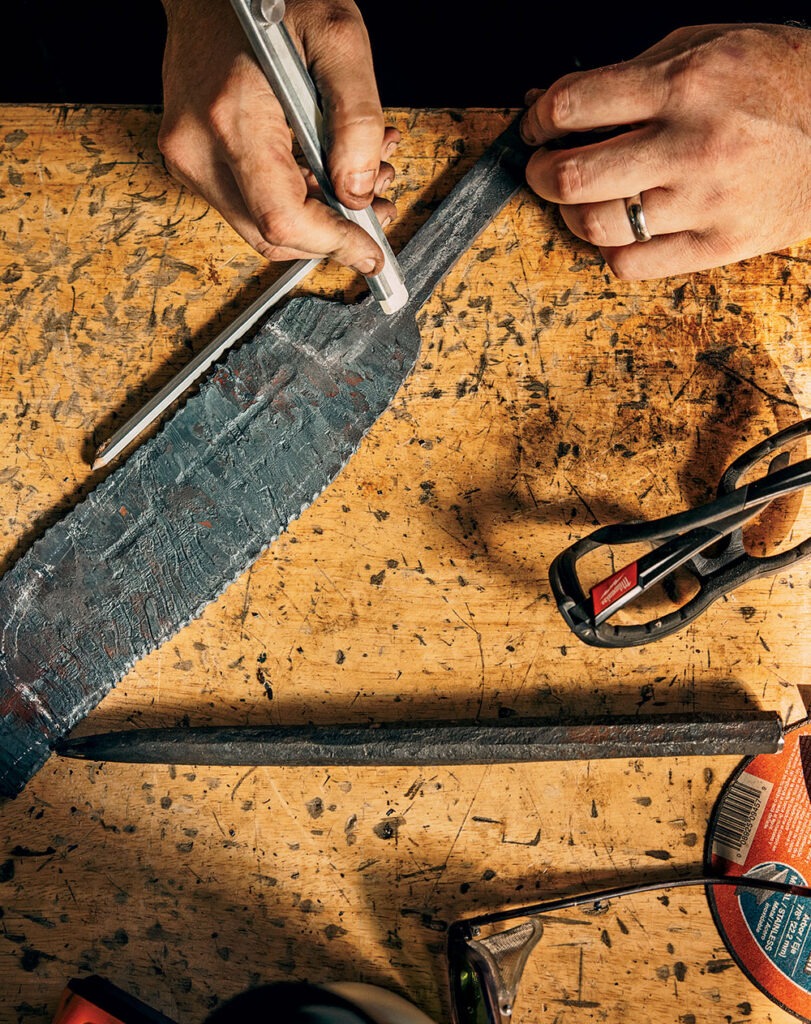
On the second day, Sam retired to the grinding booth, an enclosure he had built for his power sanding. The belt grinder is a machine of admirable complexity that can turn every which way while keeping a six-foot loop of sandpaper revolving on drums, allowing Sam to make shapes such as Western knife handles. He has to wear a respirator, a heavy apron riveted in brass, gloves, and noise-canceling headphones.
I saw Sam at his best in there. He stood in his armor, confronting a clearly dangerous and indifferent machine of stupendous mechanical capacities for removing any material that came near it, including human flesh in large bloody quantities if he slipped up. It’s a bit like a whirling wall of razor blades. Sam put both hands into this, holding something fairly small — it might have been a knife or a handle.
He is a big man, solid and steady on his feet, with wide shoulders and strong arms. He is soft-spoken, modest, and understated, a kind of gentle giant. I’d see him Saturdays at the summer farmers’ market with one or the other of his two children on his shoulder. If you met Sam, your first impression might be of calm and strength, control and competence. He’d happily show you what he can do with hammer and tongs, and you’d understand the deep dichotomy and even mystery that powers his mastery of energy and matter. What he does is simply so self-evident in the end that it cannot be questioned. When he’s done, what he puts in your hand is self-explanatory. He does not apologize. He does not explain or boast. He does not have to. It’s in your hand. And if you met him, you’d wonder: What gives him such a solid platform?
I think Sam’s mastery grew out of a catastrophic incident in his childhood. He had struggled with fire when he was young, and not in any artistic way.
I think Sam’s mastery grew out of a catastrophic incident in his childhood. He had struggled with fire when he was young, and not in any artistic way. The story of that struggle belongs to him and Simon and Phil, who went through it together, so it is not mine to tell. But I can say this much: They were trapped in an out-of-control fire when they were kids. They survived. Their parents did not.
When he came out of the grinding booth, Sam had the metal in the right shape and even close to the right size. This was called the rough grinding of the knife. Now he had to set the bevel, the angled portion of the blade that would terminate in the cutting edge. He did this with hammer and anvil, man against steel, as in images of 19th-century industrial infernos. The hammer rose toward the ceiling and then Sam put his whole back into it as it came ringing down on the steel. When he first brought the blade out of the forge, it was a tiger burning bright, and when he straightened up with the shape he was after, the black stubbly silhouette looked as if all it needed was a little stamp on the edge that said “Made in Hell.”
All morning long, a small heat-treating oven, actually a kiln that could have been used for ceramics, had been warming up. Now it had reached 1,650 degrees, the temperature at which to begin the process called “normalizing.” All of the forging and pressing and hammering and twisting of the metal had confused the internal crystal structure of the steel and introduced weird stresses among the grains.
But since the knife now had the exact shape that Sam wanted, he wouldn’t need to do anything violent to the blade again, except one final explosive act. To prepare for that, he first had to heat it back up to the point that the steel could, as he explained, relax again and release the tensions within, so that rather than being, at a microscopic level, like broken and jagged sea ice, the metal would be like a quiet millpond.
He placed the blade in the oven and closed the door. He set the timer for 10 minutes and went back to his bench to begin work on the handle. The artistry of this knife was all Sam’s doing. I had given him absolute control. But I’d spied a particular piece of wood among the materials he keeps for making handles. It was a rare Australian eucalyptus called vasticola burl, and when I’d first pointed to it, Sam smiled and said, “Oh, I love that wood.” He picked it up. It was just a block, perhaps six inches long and two inches square. He wiped some oil on it with a paper towel, and it seemed to glow.
“It looks like fire,” he said.
The fire again. He’d had his taste of fire when he was a child. And now it was in his blood.
The block was too wide for the Japanese wa handle that he was going to make, so we went into a giant room with an array of limb-snatching machines, and he cut it to size on a 1912 band saw that was taller than we were. Back at his bench, he searched in the drawers full of materials for handles and came up with a nicely patterned piece of buffalo horn for the ferrule, the protective ring between handle and blade.
“This is good,” Sam said. “It’s usually just black.”
The timer went off, and he took the blade out and put it in a rack to cool. He turned the heat down to 1,550 degrees, and when the blade had cooled, he returned it to the oven. After another 10 minutes, he put the blade aside again to cool and turned the oven down to 1,450. He repeated the 10-minute heat treating and set the blade aside once again.
“It’s still not a knife,” Sam insisted.
It was not yet good steel. It couldn’t be sharpened to take a cutting edge, and whatever edge you might put on it wouldn’t hold. It was useless for the kitchen, which was where I wanted to take it. To eat, let’s not forget. For what is a human but a transport channel for energy? And our energy comes from food. Lovely, gourmet food prepared with a fine knife. The qualities we need in a knife to create that food come from the atomic structure of the steel. But for the moment, what we had here was like a pig wallowing in mud and claiming to be cassoulet.
Sam stepped up to the oven, beside which the blade had been cooling. The oven had reached 1,475. He put the blade in and closed the door.
A slender, rectangular metal vessel sat upright on the floor by the oven. It looked somehow military, as if meant to shoot a rocket. It was filled with Parks 50, what’s known as a high-speed oil and designed for this purpose. After 10 minutes of heating to 1,475, Sam took the blade from the oven with heavy tongs and gloves and plunged it into the oil. A cloud of smoke rose to the ceiling, and a searing sound filled the room like a basket of snakes.
“This is the moment of truth,” Sam said, holding the tongs and looking away from the smoke. “This is when it becomes a knife.”
“This is the moment of truth,” Sam said, holding the tongs and looking away from the smoke. “This is when it becomes a knife.”
The quenching is a pressurized moment on which everything else turns. He cannot flinch. He cannot fake it. Like the free solo climber, he cannot make mistakes. The mere hint of a ping with the knife in the oil, and he’d have to go back to the other half of the blackened billet and start over. Because the knife would have fractured. Hard to believe, but at this point, if Sam dropped the knife, it could shatter. Some American knife makers have even taken to having a quenching ceremony to mark the birth of a knife. Some of them also think that you can quench properly only while facing north. Sam doesn’t hold to those ideas. You do your best and try to have more skill than luck.
The small heat-treating oven sat atop another oven that looked as if it wouldn’t be out of place in a 1960s kitchen. It was a tempering oven. Sam had set it to 400 degrees, and now he put the knife inside for many hours of tempering, which would finish settling the structure of the metal and would reduce its hardness to the sweet spot where it could be easily sharpened and would also hold an edge. Sam could do nothing more with this blade until the tempering was finished. So he would turn to other projects.
Before I went home that second day, Sam said, “I’ll finish the belt sanding tonight and leave about 10 percent of the hand sanding for the morning so you can watch. Assuming you like to sit there and watch people sand stuff.”
Steel is not steel. It is a chameleon, completely dependent on its environment. At temperatures such as Sam was using, it is a glowing portal to the world of the atom. Steel is iron mixed with carbon and some other elements, depending on what kind of steel you want. I had asked Sam to make me a high-carbon knife, which means that, by technical definition, at least 0.6 percent of its atoms are carbon. In practical terms, it means that it’s not stainless steel and will rust if you don’t take care of it. Sam and I like to take care of our knives the way some people like to take care of their motorcycles.
Taking care of a knife is pretty simple. You strop it before each use. You don’t throw it in the sink. You wipe it off and put it in a safe place when you’re done — a knife block, for example. And we would chop down telephone poles with it before we’d put it in a dishwasher. Then again, to qualify as a master bladesmith with the American Bladesmith Society, you have to chop a wooden two-by-four in half two times with a knife you made and then still be able to shave with it. The rules for that qualification test clearly state: “The test knife will ultimately be destroyed during the testing process.”
The knives that Sam and his fellow Midwestern smiths make, passed from hand to hand with care, from mother to son to uncle to granddaughter, could last a thousand years, by which time every speck of high technology we know today will be dust. But the reality is that if a knife maker has become too famous, you simply can’t get his or her knives any longer.
Iron atoms form crystals of various kinds, atoms connected electrically to one another. Iron atoms are like little magnets, having a north and south (positive and negative) end. So they can arrange themselves like those toys for children, magnetic shapes to create pleasing patterns.
When carbon mixes with iron, the smaller carbon atoms occupy the spaces between iron atoms. The crystal arrangement of the iron atoms changes to accommodate the carbon. Different crystal arrangements give the metal different properties. Think of it as bread. It’s like deciding what kind of bread to make. White bread. Sourdough. Hard Lithuanian black bread. Fluffy Mexican bolillos. So goes the saga of steel. The tarot cards Sam dealt at the start of this process were 1095 steel, which is iron with between 0.95 percent and 1.05 percent carbon, and 15N20, which is iron with nickel. Mixing the two is popular for making Damascus and produces an attractive pattern and a very nice edge.
As a lover of good food and good kitchen tools, I don’t need to know much about metallurgy. A bladesmith like Sam can take care of that. But I find this stuff fascinating, these amazing transformations. I like to know what’s going down in the atomic world that will blossom into these beautiful patterns of his blade.
As I watched Sam work, I kept having the impression that he was trying hard to erase something — the traces of the fire, the encroaching flames, the blackened body of the meteorite after its travels. But the erasing was also an act of creating. Michelangelo said that the block of marble contains a man, and all you have to do is remove the rock that isn’t part of the man, and then you will have your sculpture. So Sam said, “There’s a knife in there. …” And in this attitude of seeking, there is a humility that does away with the myth of the conquering hero or the towering artistic genius.
Sam does not see himself as the creator of the knife. He sees himself as having found it inside of this other, most unlikely object.
Sam does not see himself as the creator of the knife. He sees himself as having found it inside of this other, most unlikely object. As he worked, he let the steel tell him things. He followed what the material suggested rather than sticking to a predetermined plan. He was facilitating the process. He was the sorcerer. He did not invent magic, did not really make magic, but he employed magic. And with the rackety dance of hammer and tong, he was urging the knife into stelliferous being. In the process, he was also taming the fire.
Hundreds of thousands of years ago, an ape not all that different from us created an edge by fracturing one rock with a blow from another. Make no mistake. Such a knife is sharp enough to shave with. And at a stroke, the woolly mammoth could fall apart into bite-size pieces. It didn’t change everything, but it laid a dense, high-calorie, protein-packed feast on our table that allowed the relatively small inner workings of our gut to extract the tremendous amount of energy needed to grow these giant billowing brains we have. In a sense, the knife marked the birth of civilization.
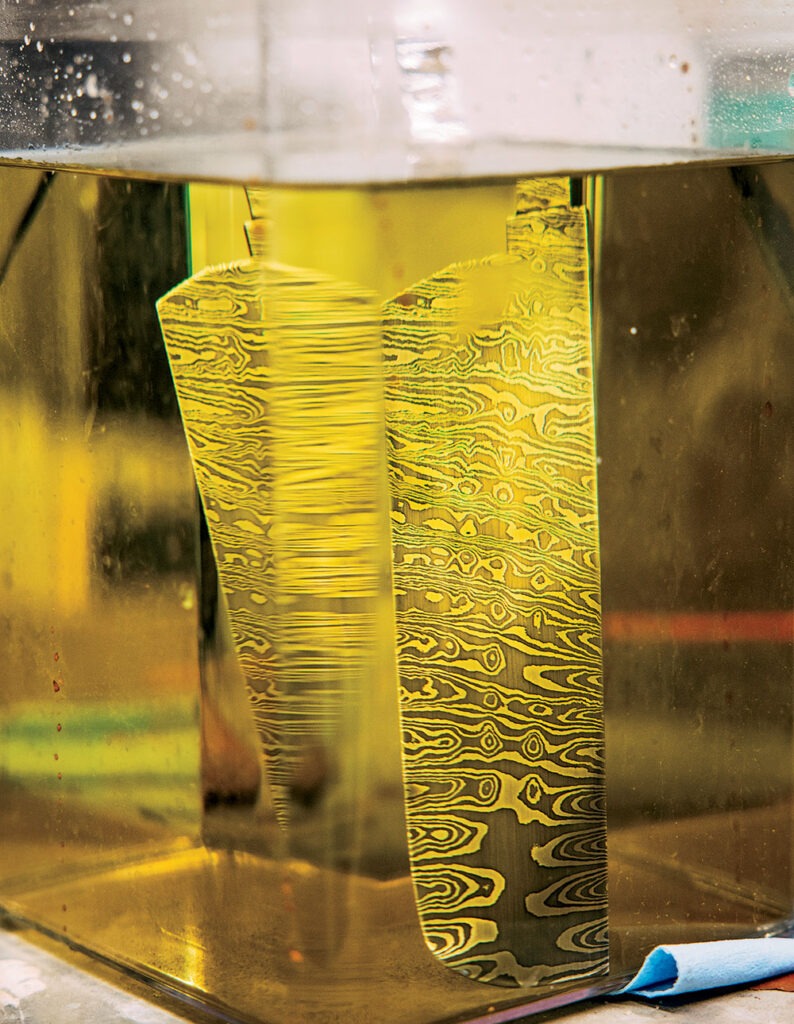
When I came in the next morning, while I did not feel that I had missed anything crucial (Sam sitting and sanding), the knife was now a revelation. It was the right size and shape, and it was all silver. It looked like a real knife awaiting a handle.
“Wow,” I said.
Sam smiled. Then, with a sly look: “Let me show you something.”
He carried the blade to the room of giant machines. Against one wall a sink was set up with gallon-size square beakers of colored liquid, one black or dark blue, one gold. “We’ll do a two-stage etch and see what we’ve got.” He washed the blade and cleaned it with Windex. He then put the blade into the dark solution. He set the timer on his watch, and when two minutes were up, he again cleaned and rinsed the blade and put it in the golden liquid. I knew that the dark fluid was ferric chloride. I asked what the golden liquid was. Sam reached to a shelf behind the sink and brought down a half-gallon bottle. It featured a cartoon alligator and was labeled “Gator Piss.”
“What’s in it?” I asked.
Sam shrugged. “Proprietary, I guess.” He left the blade to etch and went back to his bench to tidy up. “But it works,” he said.
The trade name might seem odd to those who don’t know the history of Damascus steel. Ancient Afghan makers, for example, quenched their blades in donkey urine. Some makers during medieval times believed that only the urine of redheaded boys should be used. Other Asian smiths prescribed heating the blade until it looked “like the sun rising in the desert” and then shoving it “into the body of a muscular slave.” About quenching by murder, Sam said simply, “I don’t make weapons.”
Half an hour later, he took the blade out of the Gator Piss and washed it. He held it under the lamp. We could clearly see the Damascus pattern, with its contour map of dark hills and bright craters, its sinewy valleys and far landscapes. And we could spot his signature, or maker’s mark, which he’d electrically etched on the blade. And as with looking through a microscope, the longer you looked, the more you saw.
Sam took the blade back to the bench for finer and finer sanding. “You don’t want to make it too fine,” he said. “Or the pores will close up and you’ll start to lose the sharpness of your pattern.” He would take this Damascus to 800 grit.
He had more polishing to do, more etching. The handle was a simple shape and Sam knew it well. He’d sand and polish it, and then the eucalyptus would really look like fire. He’d glue the tang into the handle. And of course, he would sharpen the knife and shave the hair on his arm to test its razor edge.
Outside the open door, I could see that the day was high and clear with light-year blue and upward-tumbling cumulus clouds that mirrored the Damascus pattern churning in the blade.
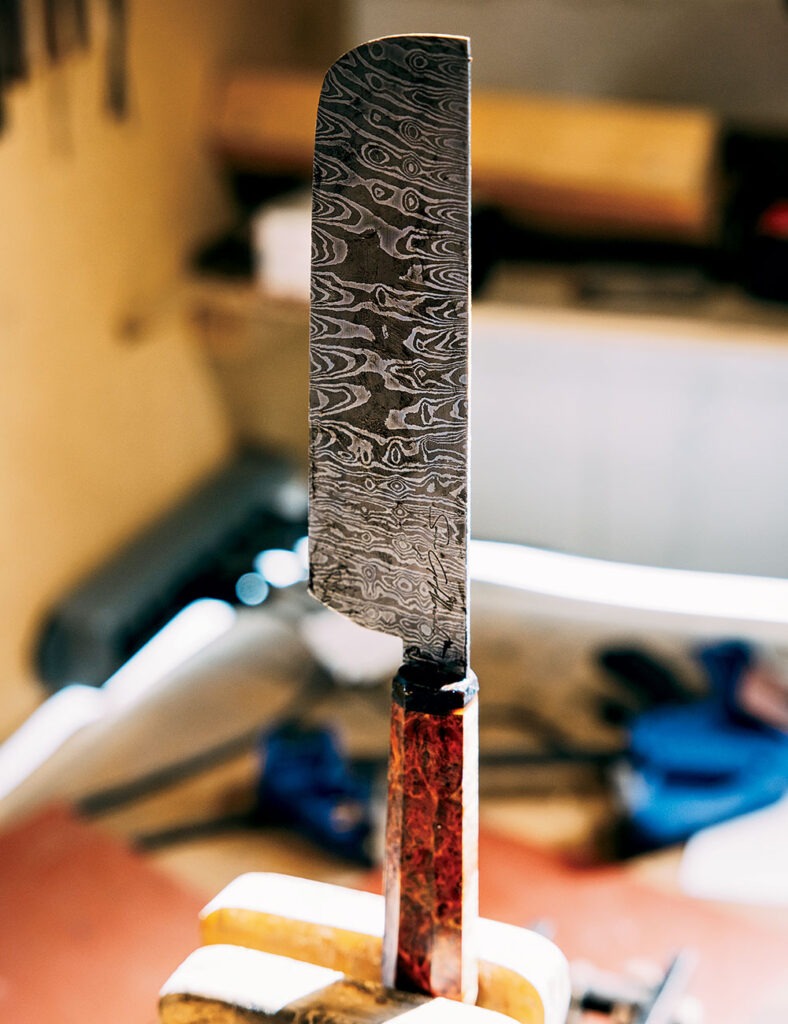
The quenching of anxiety and stress through ordered, repetitive, directed, and meaningful physical motions is an effect well known among neuroscientists and others who work with human brains and nervous systems. The rhythmic movement is soothing. Sam had tamed the fire inside and coaxed it outside to create a work both useful and beautiful. A palliative process that would give rise to a tool that would feed us and satisfy our sensibilities with its physical beauty while doing so. All of human history would thereby be embodied in a single work of art.
On the third day, when Sam presented me with the finished knife, it was so beautiful that it took my breath away. I brought it home and cut some onion for my wife, who was making dinner. The knife slid through the flesh with no resistance. It felt like cutting air. I rinsed it and wiped it dry and during dinner we propped it up in its black velvet case and we stared at it like early humans in a cave somewhere, watching fire.
![]()
